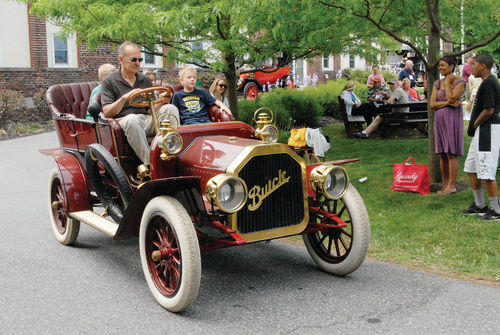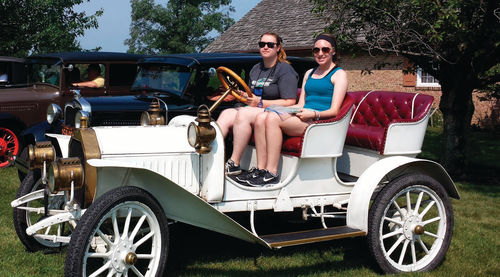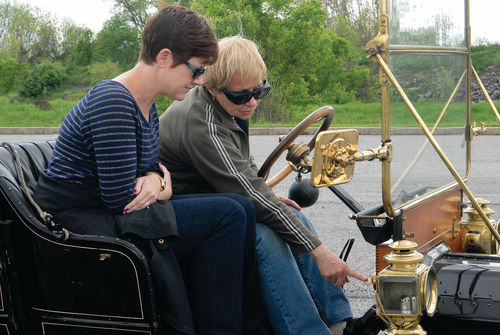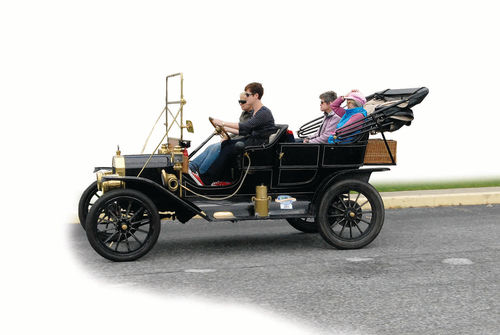Teaching Young People About the Joys of Brass
Today’s Youths Are the Key to the Future of the Vintage Vehicle Hobby. Here’s How Some Folks Are Stirring Interest In the Oldest Automobiles.
The vintage car world’s loyalties and rivalries make it easy to overlook the nearly universal agreement on the need to guide young people into the hobby.
“One of the hardest things in any organization—and the Horseless Carriage Club is no exception—is to try and entice people to come into the club,” explained Karl Darby, HCCA board chairman. “In any organization, it’s difficult to get new members. New members who are young are even harder to get because most of the Horseless Carriage Club people are older. So in order to get the younger members, you have to get their children who in turn bring their children.”
“That’s the way I came in,” said Bob Ladd, board secretary. “My dad was in the hobby and he took me on tours and stuff when I was a kid.”
An interest handed down through the family is fairly certain to bring a new generation into the hobby, but there are other ways to develop that kind of passion and in 2011, the non-profit Horseless Carriage Education Institute was established to focus on the history of the earliest automobiles. The plan was to provide educational materials to schools and service organizations as well as to HCCA regional groups and other car clubs. It also promotes displays of antique vehicles and provides scholarships and grants to colleges and trade schools with automotive restoration programs.
“We have developed two educational videos,” HCEI Trustee Larry Hoagland said. “One is aimed at elementary school students, grades four to six. The second is aimed at high school students and is also suitable for presentation to civic groups.
“The HCEI as such has no members,” Hoagland explained, “so we have to rely on other car clubs that have members and focus at least in part on the early era from horse drawn to horseless carriages, that era up through 1915.”
Getting Young People Behind the Wheel
Developing interest in the earliest cars isn’t always as organized as the HCEI’s effort. In many cases it still happens through parental involvement as it did for Bob Ladd. For example, Mike Loewenthal of Orange, Connecticut, recalled how his daughter, Ariel, drove the family’s 1908 Buick Model 10 to her high school at graduation time.
“Our friends have Ts,” he laughed, “so their son drove a 1909 Model T to school. We had to up that by having the Buick in the parking lot.”
His daughter was able to take the Buick to school because by then she’d had enough experience behind the wheel. But there’s more to the story than driving lessons. With her older brother Jared also involved, learning to drive Brass Era cars was simply another step for siblings who’d been in the hobby for a long time. Loewenthal explained that they rode in car seats mounted on the back of a Curved Dash Olds when they were very young and over the intervening years they literally grew up in the hobby. Today they both drive not only the Buick, but also a 1910 Crawford.
In addition to early participation in Brass Era tours, Ariel and Jared did what they could on the cars. Chief among
those tasks when they were young was polishing the brass. The same approach had worked when he was that young, Loewenthal recalled.

“When I was a kid, I always watched my dad and then I’d do it,” he said.
“My brothers and I learned to drive as teenagers and went on Glidden Tours and Reliability Tours. Once you learn to drive an early car, that’ll help you decide if this is something enjoyable to you or not.”
Both of his kids have probably made that decision. He pointed to Ariel’s handling of the Buick on a recent tour as well as what he did to help her prepare.
“The deal with the Buick Was trying to pick something she could crank because I might not be there when she has to start it. We had taught the rules—you have to oil the Buick twice a day—we taught her safety stops, how to brake going downhill and uphill. We would do some hour runs between homework and when you drive 70 miles in one day on a tour, you learn really quickly. And maybe because of that environment, I think, it’ll keep her interested.”
Since Jared was studying electrical engineering, he was called upon to “undo” the wiring that someone else had installed on the Buick. Loewenthal recalled that he could see mistakes his son was making because he’d already made the same mistakes and so he chose to guide rather than instruct. That helped Jared to research problems and develop solutions to them.
“I’d come back and make some suggestions,” Loewenthal said, “and then he could be proud of it because he did the wiring.”
See the USA…In Your Brass Car
HCCA Vice President Chris Paulsen’s experience was similar to Loewenthal’s as he spoke of having grown up in the hobby and passing along what he knows. His family’s vacation each summer was an antique car tour and he just assumed that everyone else’s family was doing the same thing. It left an impression.
“Looking back now, what a great way to see a good chunk of the country,” said Paulsen, an assistant professor in the restoration program at McPherson College in McPherson, Kansas. “I’ve stuck with it because I enjoyed it and I still see it as a great way to see the country. I have two daughters, 9 and 13, and fortunately, so far they see it the same way, just seeing some different parts of the country and meeting other people they wouldn’t otherwise see by doing all of the ‘touristy’ things.”
They’re doing more than that, though, as he said the most-used Brass Era car in the family is a 1910 Model T touring that’s been driven by both of his young daughters. They’ve taken it out on private property with adult supervision and Paulsen said they’re waiting for the days when they can get their licenses and head out on the road with it. And that’s not all.
“My oldest daughter has started building her own Model T,” Paulsen said. “In addition to the 1910, I have a 1914 pickup that I put together when I was in high school. We have lots of Model T parts. I’m fortunate that my father lives about 15 miles from us and also has Model Ts.
“So I said ‘yeah, we have all of these parts. If you want to build a car, we can build a car.’ So she went online, started looking at pictures, found a picture of a speedster she really likes and I said ‘sure, we can build that.’ I laid out the ground rules. I said ‘your grandfather and I are not going to do anything to it unless you’re there helping.’”
Like Lowenthal’s kids, Paulsen’s daughters have been around antique cars for their entire lives. That’s a proven recipe, agreed Karl Darby.

“My father had a Brass car in the ’50s,” Darby said, “and so I grew up with a Mercer Raceabout. He drove that car all over the place and we were having fun with it, but he passed away at 50 years old and so at that point we had to sell the car because the estate had to be settled.”
By the 1990s, he’d been through a British sports cars phase and then gotten back into Brass Era cars, a progression not completely different from Ladd’s experience.
Ladd recalled that he rode on Glidden Tours with his parents in the 1950s and bought his first Brass Era car as a young teenager.
“I was active in it for 10 or 15 years and then I was out for 25 or 30,” Ladd said. “Life took me in different directions. I was into British sports cars. I was an MG–Austin-Healey–Jaguar dealer and we were in racing, so that was really where my passion was in my middle years.
“Then an old friend from back in the early years of the (AACA) Hershey Region called me in 1999 and said ‘are you a member of the Horseless Carriage Club?’ and I said ‘no.’ He said ‘well, you should be; your picture is in their magazine.’ They did an article on Northerns and my first car was a Northern. He said ‘there’s an old picture of you at Hershey in 1955 in your Northern.’ I immediately called and joined the club and I was smitten again and eventually bought my dad’s car.”
Do a Broad “Sales” Pitch on Vintage Cars
Chris Paulsen agrees that the hobby needs to involve young people, but he goes a step further and believes that it’s equally important to attract new people of all ages. If their kids are drawn in at the same time, so much the better. He said one approach is to make sure that antique cars are seen and that their owners talk about them.
“Don’t just take your car out and park it and walk away,” he said. “If the venue allows, give some people a ride. If a family seems genuinely interested, say ‘jump in the backseat of the Model T. We’ll go for a ride. By the way, do you know you can get a running, driving Model T for less than $10,000.’ I do that a lot.”
Spreading the word can be spontaneous when someone asks more than casual questions about a car. Darby gave the example of the Beautiful Brass Cars Tour—previously Brass in Bucks County and Brass in Berks County—that’s stopped at the Montessori Country Day School in Gouglersville, Pennsylvania.
“I think the parents were enjoying seeing their kids riding in the cars,” he said. “Were they considering buying a car? No, I don’t really think that the kids would be interested in buying cars so much, but once in a while, you’ll hit the person who is interested. It’s basically cold-calling people and saying ‘hey, if you’re interested, you can contact us for more information.’”
The stops at the Montessori School gave students there about the best possible experience with Brass Era cars as it brought more than 50 examples to been seen as well as a smaller number in which they could ride. The connection between the school and the tour is a natural.
“Tracey Lescher teaches at that school,” Ladd explained. “Jeff and Tracey are perfect examples. Both of them are the children of people who were in the hobby when they were kids and now they have their two boys on everything. They had child seats in the back seat of their Overland and hauled them around and that’s the only way it’s ever going to happen.”
Getting a program involving an activity into a school can be difficult, Darby said, but it’s not impossible and Ladd explained how he managed to do just that at a school in Lebanon, Pennsylvania.
“Things happen when you talk about stuff,” he said. “I was coming back from a Phillies game on a bus and there was a guy sitting beside me who said he was a principal at a school. I said ‘you know, I really would like to bring cars in and talk about the early history of the automobile.’ He said ‘that’d be interesting, but I don’t know whether our history professors would be interested in this’ and I didn’t hear anything from him for a long time.
“The guy who finally got hold of me was not even in this guy’s school, but they knew each other. He had mentioned it and this guy just took it and ran.”

The ensuing Day of the Decade program covered more than the Brass Era with a car to represent each decade of the twentieth century. A handout lists a range including a 1907 Cadillac, a 1923 Packard, a 1954 MG and a 2006 Chrysler and explains that the students had the chance to do more than just look at the cars.
“It was great,” Ladd said, “because these kids came out and all of the owners of the cars stood in front of the cars and we talked to them about what it was like to drive in the first decade of the twentieth century, in the 1920s and so forth.”
Maybe, he agreed, some of those students will be walking through the flea market at Hershey in 20 years, but there’s also the potential for interest on the part of their parents.

“The key to that is to make the cars available for sale to the parents of these young children,” Darby said. “It has to go through the parents and if you look on the HCCA web site, we have many cars for sale that are in the $15,000-$20,000 range. It’s not a rich man’s hobby.”
Consider Mitchell and Maxwell’s Early Start
If the concerns about the hobby’s future are as valid as they’re almost universally believed to be, the efforts matter whether they involve one car-owner talking to a young person at a show or a club developing a large-scale program.
“Somebody has to inherit it,” Loewenthal observed, “and keep the hobby going.”

There are those, of course, who have that completely under control.
“There’s a person who tours in a Mitchell,” Darby said, “and he has twin boys, so the twin boys were in his Mitchell in car seats. The two boys are named Mitchell and Maxwell because he also has a Maxwell.
“You can’t tell me that those two boys aren’t going to be growing up with Brass cars.”
(Information about the Horseless Carriage Education Institute is available at http://www.horselesscarriage-edu.org).
















